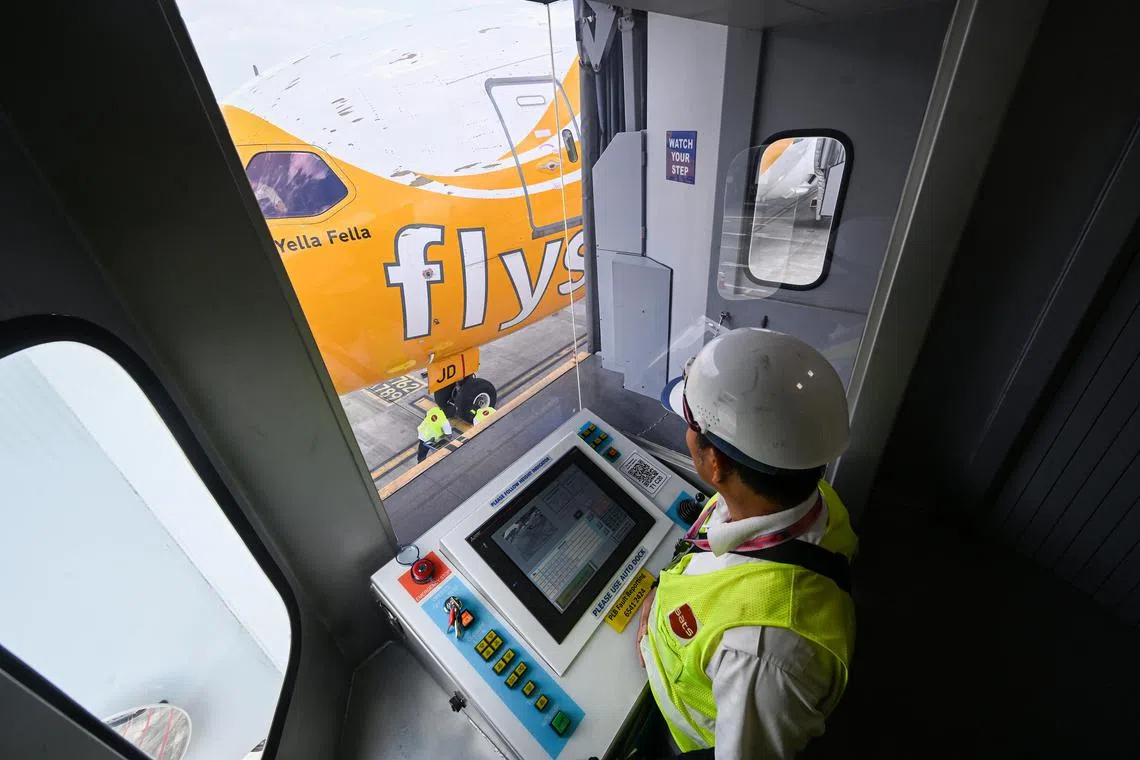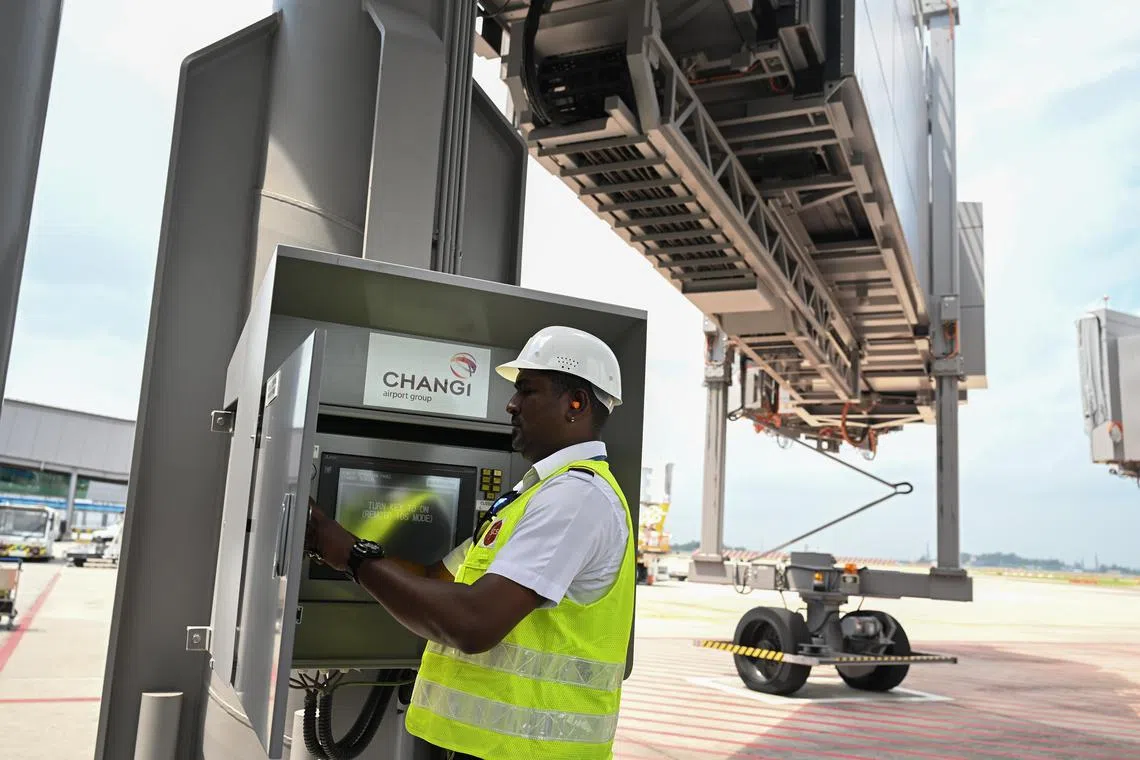Changi Airport trials fully automated aerobridge docking to improve safety and efficiency
Sign up now: Get ST's newsletters delivered to your inbox

The aerobridge has moveable arms which extend telescopically from the fixed portion.
ST PHOTO: AZMI ATHNI
Follow topic:
SINGAPORE – After a commercial aeroplane has landed and parked at Changi Airport, a flight attendant would listen out for a knock on the aircraft door.
This is the signal given by the ground handling staff that the aerobridge is in position and ready to receive disembarking passengers.
That may soon change as Changi Airport Group (CAG) trials a fully automated system that is able to safely manoeuvre the aerobridge into position.
Instead of an operator knocking on the aircraft door, a screen located at the aerobridge near an aircraft window will prompt the flight crew when the bridge is safely docked.
The trial, which began on Friday, will involve certain flights on Scoot, Bangkok Airways and KLM.
The aerobridge is a covered link that enables passengers in a plane to reach the airport terminal.
It has moveable arms that extend from a fixed portion. It has to be adjustable enough to be able to connect to aircraft of different sizes and configurations.
When a plane is secured in its parking position, the arms of the aerobridge have to be connected to the aircraft door. The aerobridge has to be close enough to the aircraft without actually touching the body and causing damage.
The system is currently semi-automated. An operator takes control of the aerobridge for the last 50cm using what looks like a gaming joystick to dock it by the aircraft door. This manual process can take up to two minutes, depending on the operator’s proficiency.
To be qualified to perform this task, an operator needs to pass a test after undergoing at least 10 hours of training.
The new automated system that is being tested is designed to complete the docking process in less than two minutes.
A CAG spokesman said that in addition to being able to perform consistently, the pre-arrival system check that is built into the system also reduces the element of human error.
An operator who has been trained to use the existing semi-automated system will need about three hours of training to use the fully automated one.
The system check is part of the standard operating procedures to test the functions of the aerobridge before docking can take place.
Through loudspeakers at the base of the aerobridge, the automated system will announce each function as it is being carried out.
Each moveable arm has 10 different sensors to detect the location of the aircraft door as well as hazards.
For example, there are two lidar (light detection and ranging) sensors at the bottom of the aerobridge, where the massive wheels are located to move the structure. The system will stop all movement if it detects hazards within a metre of the wheels.
CAG did not disclose the cost of the automated system, citing commercial sensitivities.

An aerobridge operator waiting for ground staff to insert wheel chocks to the plane’s wheels before docking the aerobridge.
ST PHOTO: AZMI ATHNI
A single remote control panel to operate the system is located on the ground, where the operator is supported by live video feed and readings from the sensors to ensure docking is progressing safely.
CAG said that this arrangement can yield potential manpower savings, unlike the existing semi-automated system where two operators are needed if they have to dock two aerobridges onto a wide-body plane with two doors. If the aircraft is an Airbus A380, three aerobridges are needed.
The airport operator also said that locating the remote control panel on the ground – or “apron” level, where the plane is parked – also paves the way for jobs to be redesigned to further improve productivity and operation efficiency.
After the docking process is completed, the operator can be deployed to do other ground handling work.
The automated system is being trialled at Gate D44 in Changi Airport Terminal 1.
The first flight to use the system was Scoot TR981, which landed in Singapore on Friday afternoon. A team from CAG was on-site to ensure that the automated docking process was completed smoothly.
The airlines and their ground handling agents participating in the trial have been briefed on the test for them to revise the processes relating to aerobridges docking with the automated system.
There are no definite deadlines set for a full roll-out of the automated system, or the duration of the trial. The spokesman for CAG said that decisions will be taken later only when data from the test can be collected.
There are about 100 gates at Changi Airport where passengers board planes. Each gate has one to three aerobridges.
The idea to fully automate the process of docking aerobridges was raised in 2017 in the first Air Transport Industry Transformation Map, which was led by the Civil Aviation Authority of Singapore (CAAS).
Such a system was expected to cut manpower needs and enhance safety by removing the risk of bridges hitting planes.

The automated system needs just one operator to manage the docking process.
ST PHOTO: AZMI ATHNI
Other countries have also trialled and adopted automated aerobridges at their airports.
Wellington Airport in New Zealand was reportedly the first in the world to use a fully automated aerobridge at one of its domestic gates in November 2018 as part of daily operations, mainly serving Airbus A320 jets.
CAAS has said that implementing automation at scale at Changi Airport will be a priority for the next three to five years.
There are two autonomous vehicle trials for baggage transport and cargo that are ongoing at Changi Airport. A small fleet of such self-driving vehicles is expected to be deployed in the next two years.


